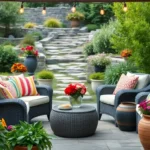White living rooms have become the ultimate design statement for homeowners seeking timeless elegance and versatility. We’ve seen this classic color choice transform countless spaces into sophisticated sanctuaries that feel both luxurious and welcoming. There’s something magical about how white decor creates an illusion of endless space while providing the perfect backdrop for any design style.
When we think about white living room decor, we’re not just talking about plain walls and furniture. We’re exploring a industry of textures, patterns, and subtle variations that create depth and visual interest. From creamy whites to crisp stark tones, each shade brings its own personality to your space.
The beauty of white decor lies in its incredible adaptability. We can easily transform a white living room from minimalist modern to cozy farmhouse simply by changing accessories and textiles. This flexibility makes white the smartest investment for any homeowner looking to create a space that’ll never go out of style.
Start With a Neutral Foundation Using White Paint Colors
Creating a stunning white living room begins with selecting the perfect paint color to establish your space’s foundation. The right white shade sets the tone for every decorative element you’ll add later.
Choose the Right White Shade for Your Space
Pure white paint creates a crisp, modern foundation that makes rooms feel larger and brighter. We recommend Benjamin Moore’s Chantilly Lace (OC-65) for spaces with abundant natural light since it maintains its true white appearance without appearing stark.
Warm white varieties like Sherwin Williams’ Creamy (SW 7012) add subtle yellow undertones that create cozy, inviting atmospheres. These shades work exceptionally well in north-facing rooms where natural light tends to feel cooler throughout the day.
Cool white options such as Benjamin Moore’s Cloud White (OC-130) feature gray undertones that complement contemporary furniture and stainless steel fixtures. These colors pair beautifully with marble accents and chrome hardware for sophisticated living spaces.
Off-white selections including Farrow & Ball’s Pointing (No. 2003) offer cream undertones that prevent spaces from feeling sterile while maintaining the classic white aesthetic. These shades bridge the gap between pure white and beige for versatile decorating flexibility.
Consider Undertones That Complement Your Lighting
Natural light direction significantly impacts how white paint appears throughout the day in your living room. South-facing rooms receive warm, golden light that enhances yellow-based whites, while north-facing spaces benefit from cool whites that counteract blue-tinted natural light.
Artificial lighting temperature affects white paint perception during evening hours when overhead fixtures and lamps become primary light sources. Warm LED bulbs (2700K-3000K) make cool whites appear more balanced, while daylight bulbs (5000K-6500K) enhance warm white undertones.
Room size considerations influence undertone selection since smaller spaces amplify paint undertones more dramatically than larger rooms. We suggest testing paint samples on multiple walls before committing to ensure undertones complement your exact lighting conditions.
Existing fixtures and finishes in your living room should guide undertone choices to create cohesive design schemes. Brass and gold fixtures pair naturally with warm white undertones, while silver and chrome elements complement cool white paint colors.
Add Texture Through White Fabrics and Upholstery
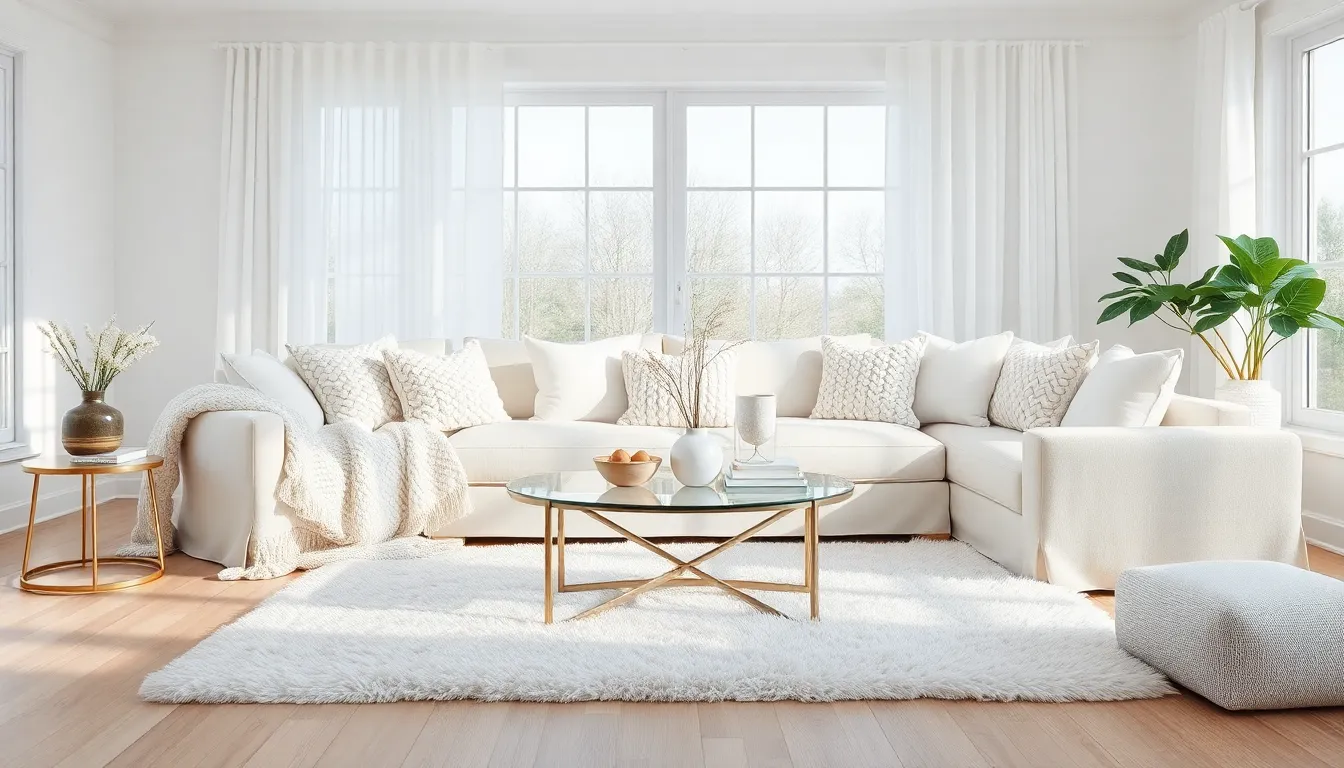
White fabrics and upholstery create the foundation for sophisticated living room decor that remains visually captivating. Strategic textile selection prevents white spaces from appearing sterile while maintaining their serene, elegant appeal.
Layer Different White Textiles for Visual Interest
Layering white textiles transforms flat monochromatic spaces into ever-changing, comfortable environments. We recommend combining area rugs, throw blankets, and cushions in varying white shades to introduce depth without compromising the cohesive color scheme. Different weaves, thicknesses, and patterns create tactile experiences that prevent spaces from feeling monotonous.
Chunky knit throws paired with smooth linen sofas demonstrate effective texture contrast in white living room decor. This combination adds visual weight while maintaining the bright, airy feeling that makes white spaces so appealing. Plush area rugs beneath coffee tables anchor seating arrangements and provide softness underfoot.
Throw pillows in various white fabrics offer opportunities to experiment with texture without permanent commitment. We suggest mixing smooth cotton covers with nubby bouclé or crisp linen options to create visual interest. Pure white and off-white combinations enhance the sense of space while adding subtle variation.
Mix Materials Like Linen, Cotton, and Velvet
Linen brings organic texture and relaxed sophistication to white living room upholstery and window treatments. This natural material creates casual elegance while reflecting light beautifully throughout the space. Its slightly rumpled appearance adds character without appearing messy or unkempt.
Cotton provides softness and breathability in white living room textiles, making it ideal for everyday seating and seasonal accessories. We recommend cotton for throw pillows and blankets because it maintains its crisp white appearance through regular washing. Its versatility allows seamless integration with other fabric types.
Velvet introduces luxurious depth and subtle sheen that elevates white living room decor beyond basic minimalism. This material catches and reflects light differently than flat weaves, creating visual richness in monochromatic schemes. Velvet accent chairs or ottoman covers add sophisticated drama while maintaining the overall white palette.
Material combinations work best when distributed throughout the room rather than concentrated in single areas. We suggest incorporating all three textures through different furniture pieces and accessories to create balanced, captivating white living room environments that feel both elegant and welcoming.
Incorporate White Furniture as Statement Pieces
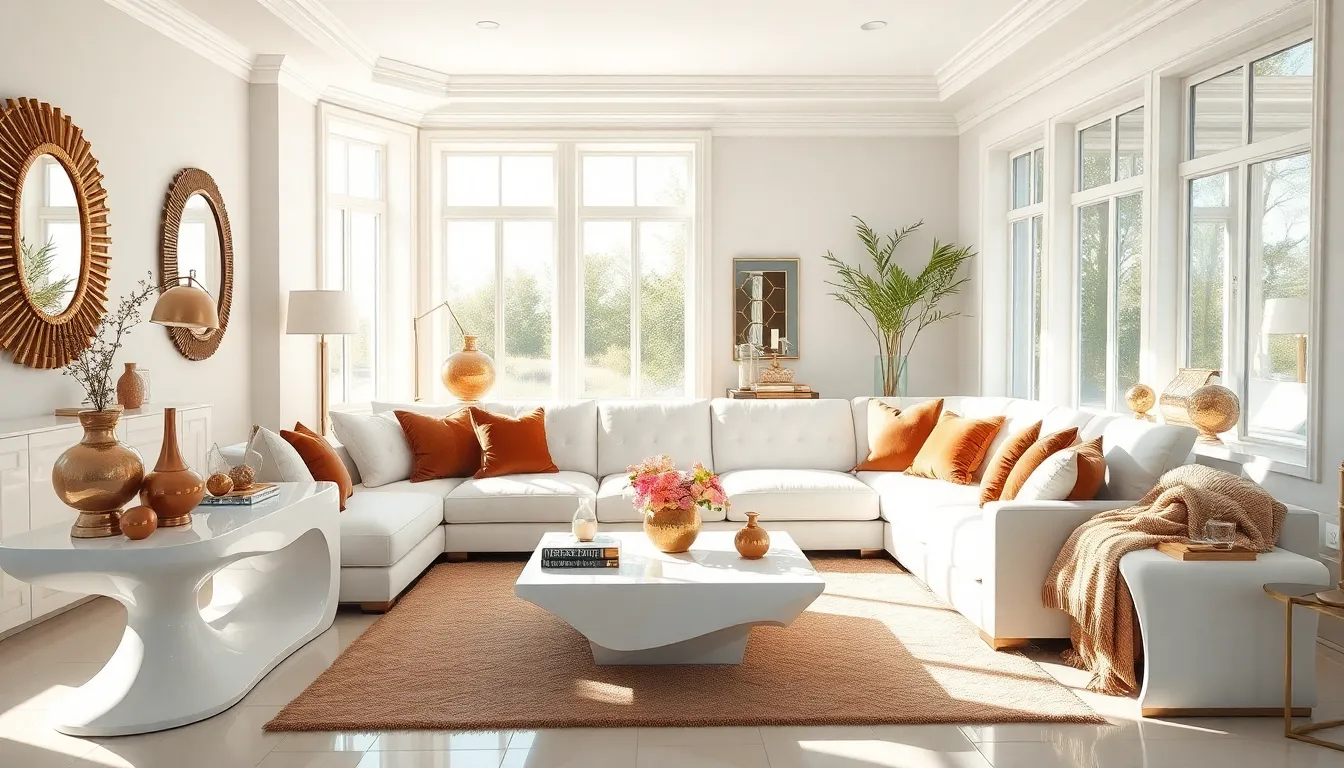
White furniture transforms living rooms into sophisticated spaces by serving as striking visual anchors that command attention through form and texture rather than color alone.
Select Key White Furniture Items as Focal Points
Choose distinctive white pieces that’ll become your room’s centerpiece and draw the eye naturally. A white sectional sofa creates an elegant foundation, while a sculptural white console table adds architectural interest to any wall. We recommend limiting yourself to 2-3 key white furniture items to avoid overwhelming the space.
Surround these focal points with complementary elements that enhance their impact. Warm metallic accents like brass or gold fixtures provide beautiful contrast against white surfaces. Wooden décor pieces and woven accessories add organic warmth, while layered textiles introduce depth and visual interest.
Layer different textures around your white statement pieces to prevent a clinical appearance. Velvet cushions offer luxurious softness, wool throws provide cozy warmth, and soft area rugs ground the entire arrangement. These textural elements work together to create an inviting atmosphere while highlighting your white furniture’s clean lines.
Balance Scale and Proportion in Your Layout
Match furniture sizes to your room’s dimensions and existing pieces for harmonious proportions. Large white sofas require appropriately sized side tables and lighting fixtures to maintain visual balance. Oversized pieces shouldn’t dominate smaller rooms, while tiny furniture gets lost in spacious areas.
Mix furniture heights and forms to create ever-changing visual flow throughout your white living room. Pair an oversized white couch with a lower profile coffee table to establish pleasing proportions. Add sculptural white chairs at different heights to break up monotonous sight lines and maintain captivating visual rhythm.
Enhance spaciousness through strategic lighting and reflective surfaces that amplify your white furniture’s impact. Ambient lighting highlights white pieces’ elegant forms, while mirrors reflect natural light and create the illusion of expanded space. These elements work together to emphasize your layout’s airy feel and showcase your white furniture’s sophisticated presence.
Create Depth With White Accent Walls and Architectural Details

Transforming our white living rooms goes beyond furniture and fabrics. Strategic architectural elements can define spaces and add sophisticated character to our design foundation.
Use White Shiplap or Wainscoting for Character
White shiplap brings instant texture and visual appeal to our living room walls. We can install this classic treatment on accent walls to introduce subtle dimension without overwhelming the space. Horizontal lines create the illusion of wider rooms while vertical installations make ceilings appear taller.
Wainscoting offers another compelling option for adding character to our white living rooms. This traditional wall treatment works particularly well in defining different functional areas within open floor plans. We can paint wainscoting in the same white shade as our walls for a cohesive look or choose a slightly different tone for subtle contrast.
Both shiplap and wainscoting serve as excellent backdrops for our white furniture pieces. These architectural details help ground larger items like sectional sofas while creating visual interest at eye level. The textural elements also complement our layered white fabrics by adding another dimensional layer to the overall design scheme.
Add Crown Molding and Trim Work
Crown molding instantly elevates the sophistication of our white living rooms. This architectural detail helps frame the space and creates a polished transition between walls and ceilings. We can choose from various profiles ranging from simple clean lines for modern spaces to more ornate designs for traditional aesthetics.
Trim work around windows and doorways enhances the overall elegance of our white decor. White trim creates crisp lines that define architectural features while maintaining the cohesive color palette. These details work particularly well with our white paint foundation by adding depth through shadow lines and dimensional elements.
Baseboards and chair rails provide additional opportunities to incorporate trim work into our design. These horizontal elements help break up large wall expanses and create visual balance with our white furniture arrangements. We can use different trim heights and profiles to complement our room’s proportions and architectural style.
Introduce Natural Elements to Warm Up White Spaces
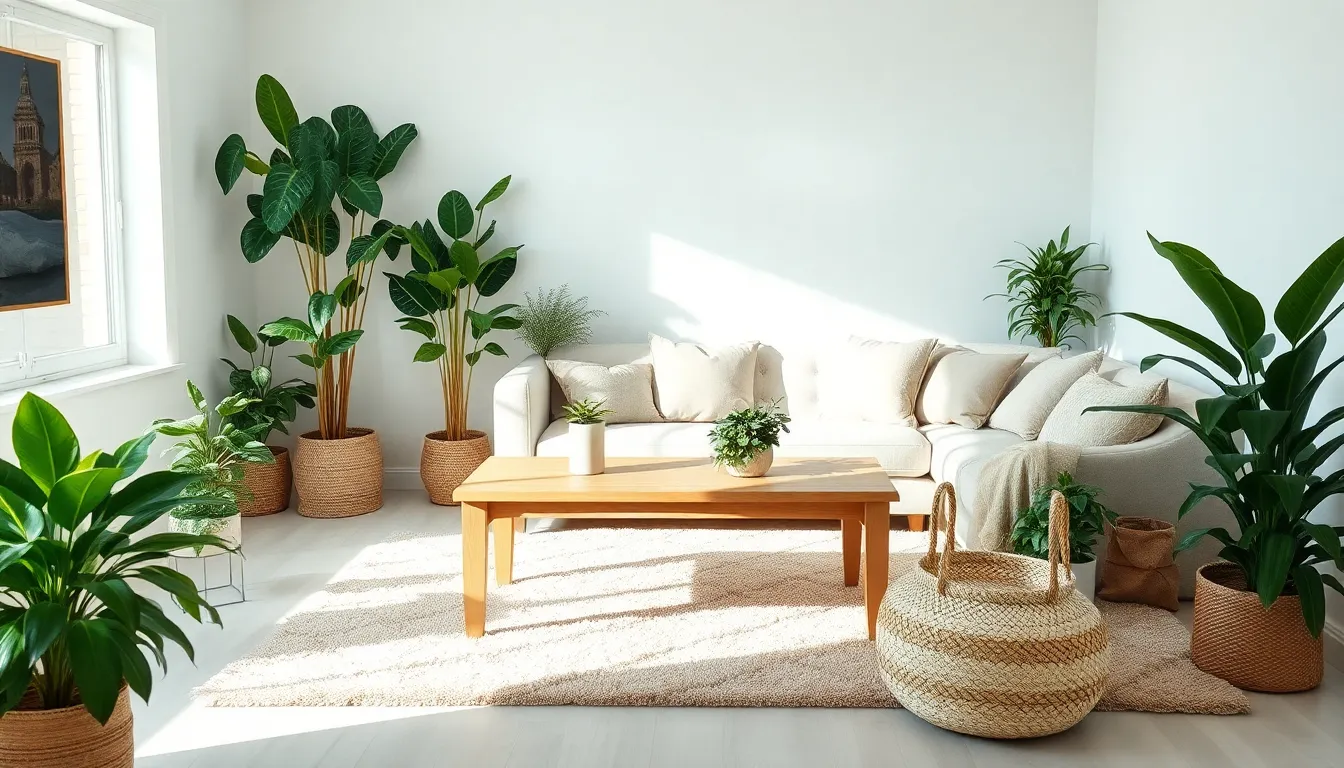
Natural elements transform sterile white rooms into inviting spaces that feel connected to the outdoors. We’ll show you how to incorporate organic materials that add warmth and personality to your white living room decor.
Bring in Wood Tones and Greenery
Wood tones create essential contrast against white backgrounds while introducing warmth that makes spaces feel more inviting. We recommend incorporating wooden furniture pieces like coffee tables, floating shelves, or decorative accent pieces that provide visual weight and natural texture. Flooring options such as hardwood or wood-look tiles establish a grounding foundation that balances the lightness of white walls and furniture.
Greenery brings life and vibrancy to white living rooms through houseplants and fresh flower arrangements. We suggest placing large floor plants like fiddle leaf figs or snake plants in corners to create focal points, while smaller potted plants on side tables and shelves add layers of natural color. Plants purify the air naturally while introducing organic shapes and textures that soften the clean lines of white decor.
Combining wood and greenery creates a harmonious connection to nature that enhances the overall mood of your living room. We find that mixing different wood tones from light oak to deeper walnut adds depth, while varying plant sizes and types creates visual interest throughout the space.
Use Natural Fibers and Organic Shapes
Natural fiber textiles soften white living rooms by adding varied textures that create depth and visual appeal. We recommend incorporating materials like wool, cotton, jute, rattan, and linen through area rugs, throw pillows, and blankets that invite touch and comfort. These organic materials balance the simplicity of white while introducing subtle patterns and weaving techniques that catch light differently throughout the day.
Organic shapes in furniture and decor counteract any potential coldness from predominantly white palettes. We suggest choosing curved sofas, round coffee tables, or irregular shaped vases that create a relaxed and welcoming atmosphere. These flowing forms add movement to rectangular room layouts while maintaining the sophisticated elegance of white decor.
Mixing different natural textures creates layered, ever-changing looks that can adapt to various design styles from modern to farmhouse. We find that combining woven baskets, linen curtains, and wool throws provides tactile variety that makes white living rooms feel warm and inviting rather than clinical or sterile.
Play With White Lighting Fixtures and Lamps

White lighting fixtures create seamless integration while maximizing the brightness potential of your white living room decor. These fixtures maintain the airy, cohesive aesthetic that makes white spaces feel open and refreshed.
Choose Statement White Chandeliers or Pendants
Bold white chandeliers transform your living room into an elegant focal point that commands attention without disrupting the monochromatic scheme. These sculptural pieces add both illumination and visual interest through their form and texture rather than relying on color contrast.
Statement lighting fixtures range from modern geometric designs to classic white shades that elevate your room’s sophistication. White pendants work particularly well in spaces with higher ceilings, creating dramatic vertical elements that draw the eye upward.
Chandelier placement should consider your furniture arrangement, positioning these fixtures to complement rather than compete with your white sectional sofa or console table. The sculptural quality of white statement lighting adds the dimensional interest that prevents your space from feeling flat or monotonous.
Layer Ambient and Task Lighting
Ambient lighting provides the foundation for your white living room’s overall illumination, typically delivered through overhead chandeliers or pendant fixtures. This general lighting ensures your space feels bright and welcoming throughout the day.
Task lighting addresses exact functional needs like reading or focused activities through strategically placed table lamps and floor lamps. These fixtures allow you to adjust brightness levels based on your activities while maintaining the cohesive white aesthetic.
Accent lighting highlights artwork, architectural details, or decorative elements within your white decor scheme. This targeted illumination creates depth and prevents your space from appearing washed out by purely white surfaces.
Layering these three lighting types provides flexibility and enhances both mood and usability in your white living room. The combination prevents the space from feeling flat while adding warmth through varied light sources and intensities.
Warm bulbs balance the clinical feel that can sometimes accompany white lighting fixtures, adding coziness and comfort after dark. This approach complements your white palette while creating an inviting atmosphere that feels both sophisticated and welcoming.
Style White Shelving and Storage Solutions
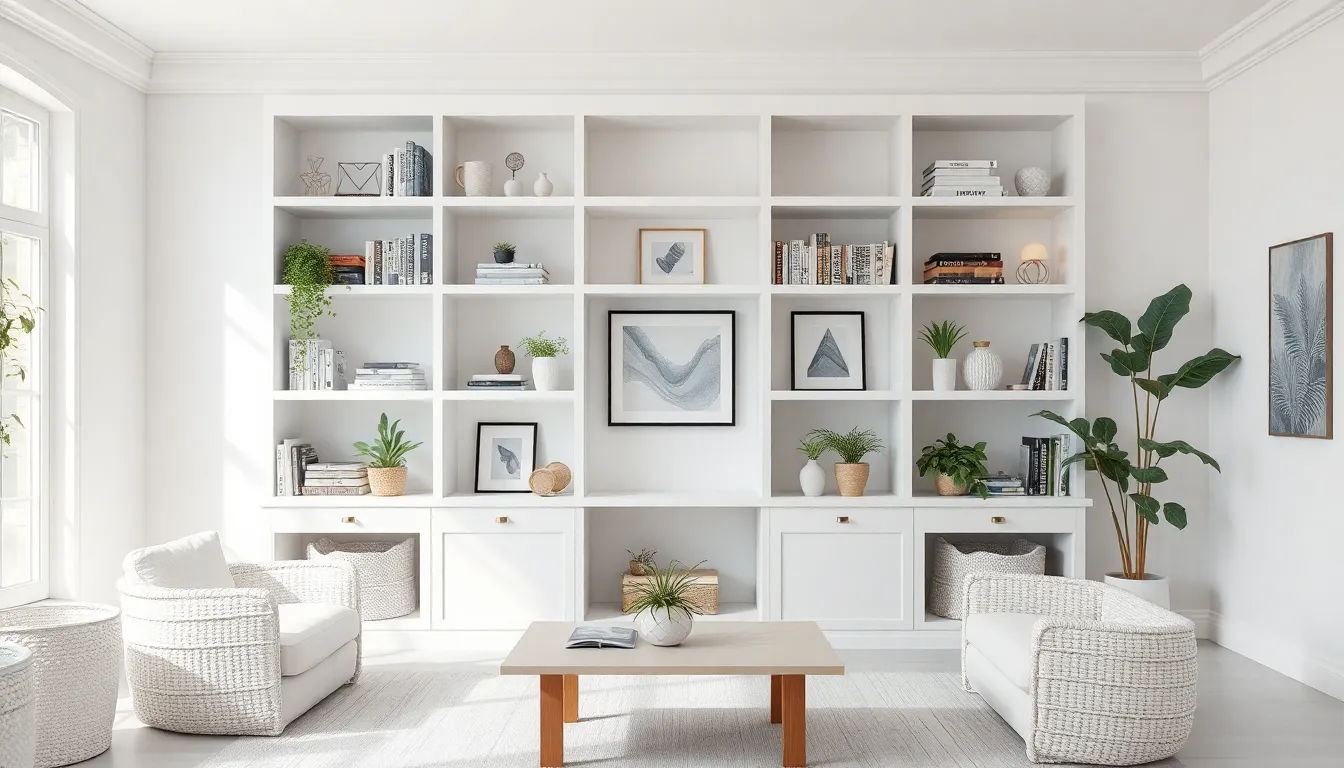
White shelving units offer functional storage while maintaining the light and airy feel we’ve established throughout our living room design. We can choose between streamlined minimalist designs for modern spaces or traditional styles that add warmth and charm to our white decor.
Display Curated Collections in White Bookcases
Showcase your collections against white bookcase backgrounds to create stunning focal points that let colors and shapes pop without overwhelming the room. Books, art objects, plants, and decorative items gain visual prominence when displayed against neutral white shelving, creating gallery-like presentations within our living spaces.
Balance open and closed storage to maintain an orderly and elegant appearance throughout our white bookcases. Grouping objects by color or theme creates cohesive displays, while mixing different heights and textures adds visual interest to each shelf section.
Incorporate materials and textures like woven baskets, ceramic vases, and metallic accents on shelves to add depth without disrupting our white palette. Varying finishes prevent the overall look from feeling flat or sterile, creating layers of visual complexity that enhance our curated collections.
Organize with White Storage Baskets and Containers
White storage baskets and containers unify our decor while providing practical organization answers that maintain our room’s serene atmosphere. Styles range from rustic woven baskets to sleek fabric bins, each adding different layers of texture and softness to complement our white living room design.
Fabric, wicker, and plastic containers offer texture contrasts that work seamlessly within our white theme while organizing clutter discreetly. These storage answers effectively stash throw blankets, magazines, and toys while improving the consistent white aesthetic we’ve created.
Position storage answers inside shelves or under coffee tables to keep essentials accessible yet hidden from view. This approach maintains our room’s tidy appearance while ensuring we have practical storage that doesn’t compromise the elegant white atmosphere we’ve carefully designed.
Add Subtle Color Accents to Enhance White Decor

Building upon our white foundation, we can transform sterile spaces into vibrant yet sophisticated living areas through carefully chosen color accents. Strategic color placement maintains the serene elegance while adding personality and warmth to our white living room design.
Use Muted Tones That Complement White
Soft pastels breathe life into white spaces without overwhelming the clean aesthetic. Pastel pinks, sky blues, light oranges, and gentle yellows work beautifully as accent colors through throw pillows, artwork, and small furniture pieces. These subtle hues lift the neutral palette while preserving the room’s tranquil atmosphere.
Natural elements introduce organic color variations that enhance white decor. Plants bring fresh greens that complement white walls, while wooden accents add warm brown tones that create visual depth. We recommend incorporating these elements through coffee tables, picture frames, or decorative bowls to establish organic harmony.
Soft greys and beige tones create sophisticated layers within white schemes. These muted neutrals work exceptionally well for larger pieces like area rugs or accent chairs. Keeping furniture pieces in brighter whites while using softer whites or muted tones on walls prevents the space from feeling flat or clinical.
Metallic accents in silver or gold add subtle glamour without disrupting the clean aesthetic. Picture frames, lamp bases, and decorative objects in these finishes create elegant focal points. We suggest limiting metallic elements to 2-3 pieces per room to maintain the sophisticated balance.
Texture mixing deepens warmth through plush throws, soft rugs, and velvet cushions. These varied materials in muted tones ensure our white rooms feel inviting rather than stark. Layering different textures creates dimensional interest while maintaining the cohesive color palette.
Incorporate Seasonal Color Changes
White living rooms serve as versatile blank canvases ideal for seasonal transformations. This adaptability allows us to refresh our spaces throughout the year without major renovations. The neutral foundation accommodates changing accent colors while maintaining the room’s core elegance.
Holiday seasons call for sophisticated color combinations that enhance white decor. Green and gold accents during winter holidays create festive yet refined atmospheres. We can introduce these colors through decorative pillows, table runners, or small ornamental pieces that easily transition after the season ends.
Autumn celebrations come alive with warm pumpkin and orange hues in strategic placements. Armchairs, throw blankets, or decorative accessories in these tones create cozy seasonal appeal. These warmer colors complement white backgrounds while adding the perfect amount of seasonal character.
Spring brings opportunities for fresh floral prints and pastel accent pieces. Soft pink, mint green, or lavender elements through artwork or textiles celebrate the season’s renewal. We recommend rotating these lighter colors in through easily changeable items like cushion covers or small decorative objects.
Summer calls for coastal inspired blues and sandy beige accents. These colors evoke relaxation while maintaining the sophisticated white foundation. Incorporating these tones through lightweight fabrics and decorative elements keeps our living rooms feeling fresh and airy during warmer months.
Maintain Your White Living Room Decor

Keeping your white living room pristine requires strategic material choices and consistent care routines. We’ll share practical approaches that preserve the elegance while minimizing maintenance challenges.
Choose Practical White Materials for High-Traffic Areas
Furniture and upholstery selections should prioritize durability in busy spaces. White furniture with stain-resistant fabrics or treated leather offers easier cleaning in high-traffic zones. Slipcovers on sofas and chairs provide removable laundering options that keep your seating fresh.
Flooring materials demand careful consideration for white living rooms. Ceramic tile, laminate, or washable vinyl provide better resistance to dirt and stains than traditional carpeting. High-quality washable rugs complement these surfaces while offering the comfort of soft textures underfoot.
Wall and trim finishes should use semi-gloss or satin paint options instead of matte varieties. These finishes resist marks more effectively and allow easier cleaning when spots appear. Satin sheens particularly balance durability with the sophisticated appearance your white decor deserves.
Storage answers benefit from practical white materials like treated wood or sealed surfaces. White storage baskets and containers maintain the cohesive aesthetic while providing functional organization. Woven baskets add texture variation while staying within your color scheme.
Establish Cleaning Routines for White Surfaces
Weekly maintenance prevents dirt buildup through regular dusting and vacuuming. Sweep or vacuum floors consistently to remove particles before they embed in surfaces. Dust upholstery and furniture weekly using microfiber cloths that capture debris without scratching.
Immediate spot cleaning protects white surfaces from permanent staining. Address spills quickly using appropriate cleaners for each surface type. Test cleaning products in inconspicuous areas before full application to avoid discoloration or damage.
Deep cleaning schedules ensure long-term preservation of your white decor. Steam cleaning or professional services handle periodic deep maintenance for upholstery and carpets. Schedule these sessions seasonally or as needed based on usage patterns.
Natural light maximization enhances your room’s brightness while supporting cleanliness. Keep windows clean to maintain the airy feel that makes white living rooms so appealing. Use adjustable window treatments to control brightness and privacy while showcasing your carefully maintained white surfaces.
Conclusion
White living room decor offers endless possibilities for creating spaces that are both timeless and personally meaningful. We’ve seen how this versatile foundation allows for creative expression while maintaining an elegant sophistication that never goes out of style.
The beauty of white decor lies in its ability to evolve with our changing tastes and lifestyle needs. Whether we’re drawn to minimalist aesthetics or prefer layered textures and natural elements our white foundation supports every vision we have for our homes.
By implementing the strategies we’ve discussed we can create living rooms that feel fresh bright and welcoming for years to come. White decor isn’t just a design choice—it’s an investment in creating spaces where we truly love to live.
Frequently Asked Questions
What makes white living rooms so popular among homeowners?
White living rooms are popular because they create elegant, versatile spaces that feel both luxurious and inviting. White decor offers incredible adaptability, allowing homeowners to easily switch between design styles from minimalist to cozy by simply changing accessories and textiles. This timelessness makes white a smart investment for any home.
How do I choose the right white paint shade for my living room?
Consider your room’s lighting and size when selecting white paint. For bright spaces, try Benjamin Moore’s Chantilly Lace for a crisp look. For cozier atmospheres, opt for warm whites like Sherwin Williams’ Creamy. Test samples in different lighting conditions to see how undertones appear throughout the day.
How can I add texture to prevent my white living room from looking sterile?
Layer different white textiles like area rugs, throw blankets, and cushions to create depth. Incorporate various materials such as linen for organic texture, cotton for softness, and velvet for luxury. Distribute these textures throughout the room to create a balanced, inviting space that feels elegant rather than clinical.
What white furniture pieces work best as statement items?
Select 2-3 key white furniture pieces like a white sectional sofa and sculptural console table as focal points. Surround them with complementary elements like warm metallic accents and wooden decor. Mix furniture heights and forms to maintain visual interest while ensuring pieces match your room’s dimensions.
How can architectural details enhance white living rooms?
Add white shiplap or wainscoting for texture and visual appeal. Shiplap creates the illusion of wider rooms, while wainscoting defines functional areas in open floor plans. Crown molding and trim work elevate sophistication and create polished transitions between walls and ceilings, adding depth to your design.
What natural elements work well in white living spaces?
Incorporate wood tones through furniture and flooring to provide warmth and contrast. Add greenery with houseplants and fresh flowers to bring life and vibrancy. Use natural fibers like wool, cotton, and jute in textiles, and include organic shapes in furniture to soften the white palette.
How should I approach lighting in a white living room?
Use white lighting fixtures to create seamless integration that maximizes brightness. Layer ambient, task, and accent lighting for flexibility. Consider statement white chandeliers or pendants as focal points. Choose warm bulbs to balance any clinical feel and create a sophisticated, welcoming atmosphere.
What storage solutions maintain the airy feel of white living rooms?
Choose white shelving that complements your decor style, whether minimalist or traditional. Display curated collections in white bookcases and balance open and closed storage. Use white storage baskets and containers for practical organization while incorporating materials like woven baskets and ceramic vases for added texture.
How can I add color accents without overwhelming white decor?
Use muted tones like soft pastels and natural elements to add warmth and personality. Consider seasonal color changes to refresh your space throughout the year while maintaining the white foundation. Choose subtle accents that complement rather than compete with your white color scheme.
What’s the best way to maintain white living room decor?
Choose practical materials like stain-resistant fabrics and easy-to-clean flooring such as ceramic tile or washable vinyl. Use semi-gloss or satin paint finishes for easier cleaning. Establish regular cleaning routines including weekly dusting, immediate spot cleaning, and scheduled deep cleaning to preserve the pristine appearance.




